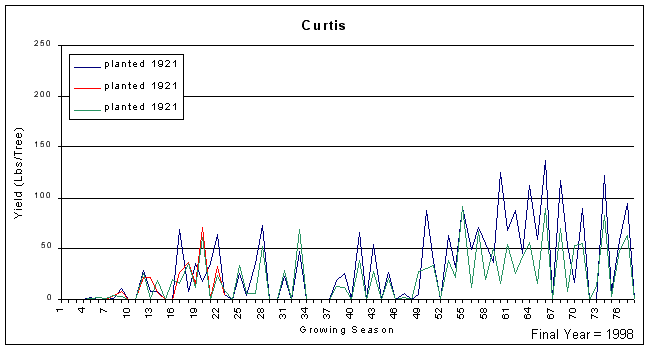Curtis

Average nut quality of test trees.
| # Nuts / lb. | % Kernel | Kernel quality breakdown | Specific gravity | ||
| % Fancy | % Standard | % Amber | |||
| 89 | 54% | 23% | 29% | 2% | .77 |
History
The original tree of this cultivar was grown from a nut of the 'Turkey Egg' cultivar. The nuts were planted as a seedling orchard in 1886 by Dr. J.B. Curtis, Orange Heights, Fla. In 1896, Dr. Curtis propagated this cultivar and began initial dissemination. In 1988 the tree was still producing nuts. 'Curtis' was popular in southeastern Georgia and south to middle Florida. 'Curtis' has been used in pecan breeding and one cultivar, 'Houma', has been released with 'Curtis' parentage (Sparks, 1992).
Comments
*Note: This is an older cultivar planted in the Old Variety Test at the Tifton Campus. Trees were planted decades ago when care was very different than it is now, and trees received much less care, so production data will reflect this fact. Trees began receiving insecticides in 1962, fungicides in 1970, nitrogen in 1962, and drip irrigation in 1975. The data for this cultivar was collected by several individuals, but the bulk of the data and the comments are from my predecessor Dr. Ray Worley. This information was originally published here: Worley and Mullinix, 1997.
'Curtis' has a small, late-maturing nut with high percentage kernel. A flecking on the kernel testa might be objectional to some markets. It has had a good resistance to scab for a long time and seems to be an easy keeper tree. Its small size (89 nuts/lb), low yield, and late maturity are its biggest minuses. This cultivar isn't productive enough for commercial groves. It would, however, be a fairly good choice for a yard tree. The yield is usually low enough that the quality is good, and the kernels are nice and oily. Along with 'Elliot', 'Curtis' nuts are often used for rootstock seed in the Southeast.
Production record of test trees beginning in year planted
'Curtis' production from the Old Variety Test. Each colored line represents the yearly production in pounds of nuts from an individual tree beginning the year planted.
Alternate Bearing Intensity* = 0.59
*Computed from mature trees using data from years after trees began receiving fertilizer and pesticide sprays.

